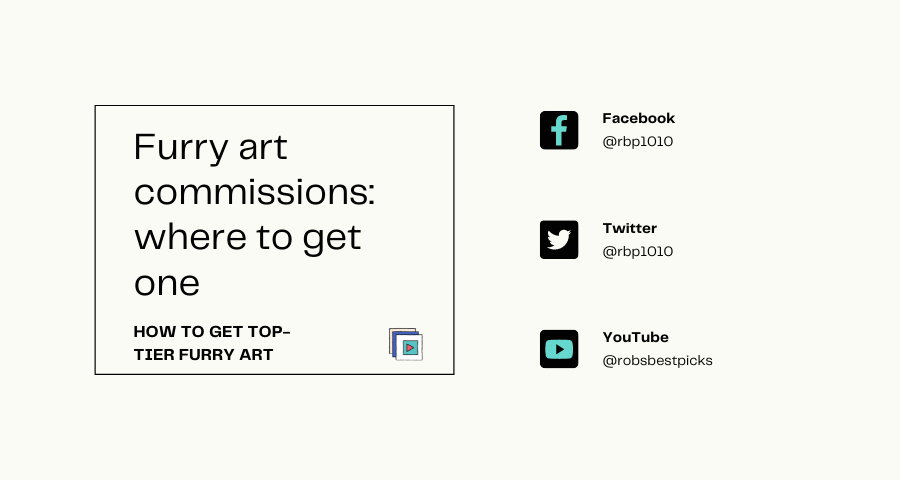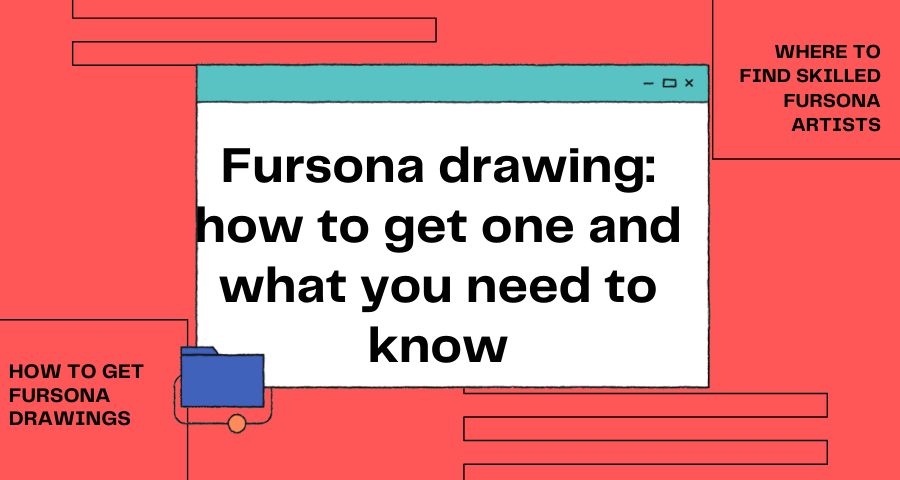Think of 3D artists as the elitist force of the graphics design and animation world – they use top draw techniques and tools to create some awe-inspiring artwork. In keeping with that elitist characterization, they are also one of the toughest graphics artists to hire.
I’ve been hiring freelancers for well over ten years now, and never was it as challenging to hire a freelancer as when I tried to staff a 3D character design role for one of my dev friends.
If you’re here, you’re probably in the same boat as I was a couple months back. I outline everything I learnt about hiring a 3D artist in this guide so you can find a great artist without all the mind draining research I had to go through.
The hiring pitfall
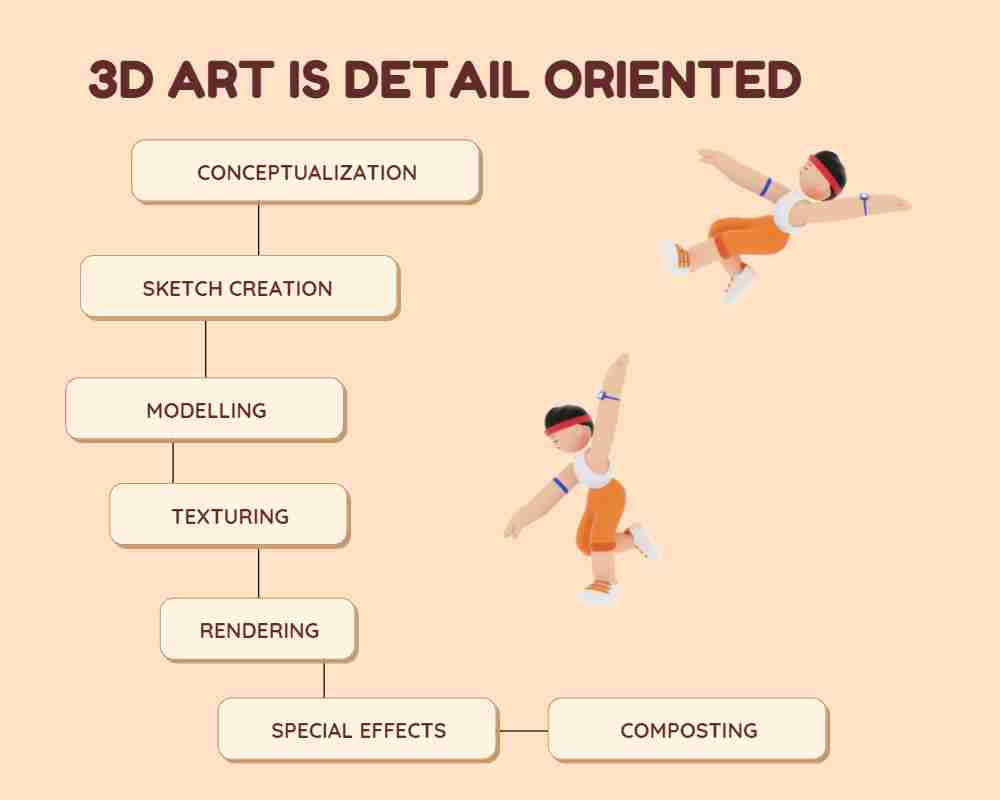
Many people assume the process of creating 3D art to be vastly similar to what it takes to make 2D art and likewise correlate the hiring process for 3D artists to that of 2D artists. Pro-tip. It’s not. While 2D artistry is mainly a product of creativity and skill, 3D art is much more technical business.
The average 3D art design process goes something like this:
- Conceptualization
- Sketch
- Modelling
- Texturing
- Rendering
- Composting
- Special effects
To put it simply, 3D art is 2D art with extra depth and perspective. Creating this extra depth and perspective is laborious. It’s why there are fewer 3D artists compared to 2D artists, but more importantly, it’s why 3D artists cost more – in order of magnitudes more – than the average 2D artist.
Many business owners, creative directors, and game developers experience some kind of reality shock when they get their first quote for a 3D art commission. The assumption is that it should be as cheap or not that far away in pricing as 2D art.
The high markup from skilled 3D artists usually turns first-time 3D art buyers the way of cheaper, almost-always less skilled 3D artists. Except for typical run of the mill commissions, that’s always a recipe for disaster. Good 3D art takes time, skill and expertise to develop. Skilled 3D artists will charge reasonably high rates to compensate for their efforts. If you want quality stuff, you need to pay these rates.
That said, high rates don’t automatically translate to a good 3D artist; you still need to vet the skills and expertise of any potential hire. Here’s how to go about it
What to look out for in the ideal 3D artist
Creativity
3D art is still art. So while I’ve been yammering about technical proficiency and skill with relevant software, creativity and artistic skill are still the base requirements for any 3D artist. At the very least, they are what determine how a 3D artist would go about conceptualizing a 3D design. If the concept art is bad, the final results won’t be any better regardless of how good the artist is at completing the other more technical aspects of 3D design.
How to test this
You want to see the artist’s workflow. That is, how they go from idea, concept design, pre-touch to completed design. If you’re hiring a 3D artist on a place like Artstation or DeviantArt trailing a potential hire’s workflow is usually a simple case of assessing their profile.
On freelance sites like Fiverr and Upwork, you’ll mostly get to see finished jobs on artists’ profiles. You might need to ask for a link to their portfolio website or profile. Case studies are also a good way to assess creativity and artistic skill since most will include the conceptualization phase of the 3D design process.
In-depth technical expertise with pro-3D tools
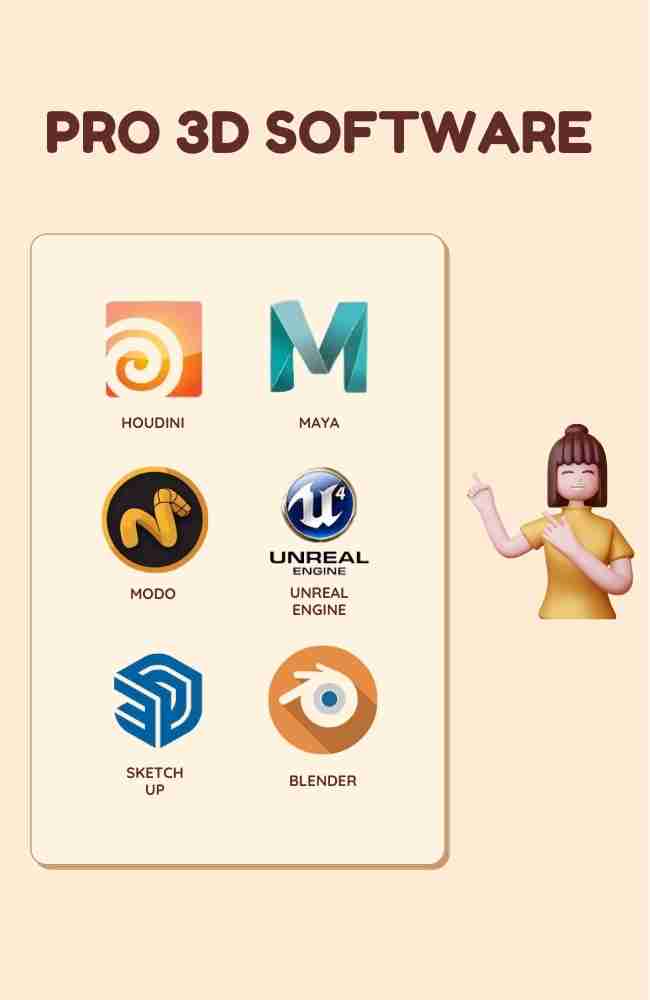
Unlike 2D art, which can be completed on one or two design applications creating a detailed 3D art piece usually involves passing a design through several 3D sculpting tools. If an artist is to produce quality 3D art, they must be well versed with these tools.
Some 3D artists only have expertise with a limited set of tools, and depending on your needs, this could be an issue. For instance, if you’re looking to get scenic 3D art done as opposed to lone 3D character design, you want someone who’s skilled with lighting on software like Modo. An artist who’s only good with model design and texturing might struggle with producing the complete scene.
How to test for this
Ask questions about their skills and the software they use.
Alternatively, you could ask for portfolio samples related to the 3D design you have in mind. And speaking of portfolios:
Expansive portfolio and industry experience
When it’s all said and done, portfolios are the best way to gauge the skill and expertise of any 3D artist. When assessing a 3D artist, you want portfolios related to the gig you have in mind. 3D art, like many sophisticated art disciplines, is highly specialized. You can have an artist who absolutely rocks with character design but has no clue how to find their way around 3D animation.
Industry experience is another key metric. 3D artists who’ve completed more real-world projects and collaborated across teams are better equipped to produce 3D designs. That said, if an artist’s portfolio is expansive and impressive enough, I won’t punish them for having little to no industry experience.
How to test this
It’s simple to ask for portfolio samples and keep in mind that the nearer the sample is to your project, the more relevant it is. You want samples that showcase all the skills required to complete your project. If you’re gunning for high definition 3D art, ideal samples should show detailed 3D texturing, well-placed lighting and the likes.
Industry experience is measured by asking about who and what companies the artist has worked for or worked with. Bonus points for artists who’ve worked with high rise 3D animation studios like Disney.
These three traits define an excellent 3D artist on a broad level. To get an organizational fit, it’s important to consider the accessory soft skills like communication, attention to detail and the likes. All those are mostly industry/business/person-specific, so I won’t be diving into them.
Let’s now turn our focus to where you can find 3D artists for hire.
Where to find and hire 3D artists online
With the rise to popularity of freelance sites like Upwork and Fiverr, finding and hiring a 3D artist is a little bit easier. But freelance sites are not the only places where 3D artists hang out. Before there were dedicated 3D art categories on freelance sites, specialized portfolio sites like DeviantArt and, more recently, Artstation provided a means to find and hire 3D artists.
I’ll give a brief rundown of how to find a 3D artist on all three channels
Finding a 3D artist on freelance sites like Fiverr and Upwork
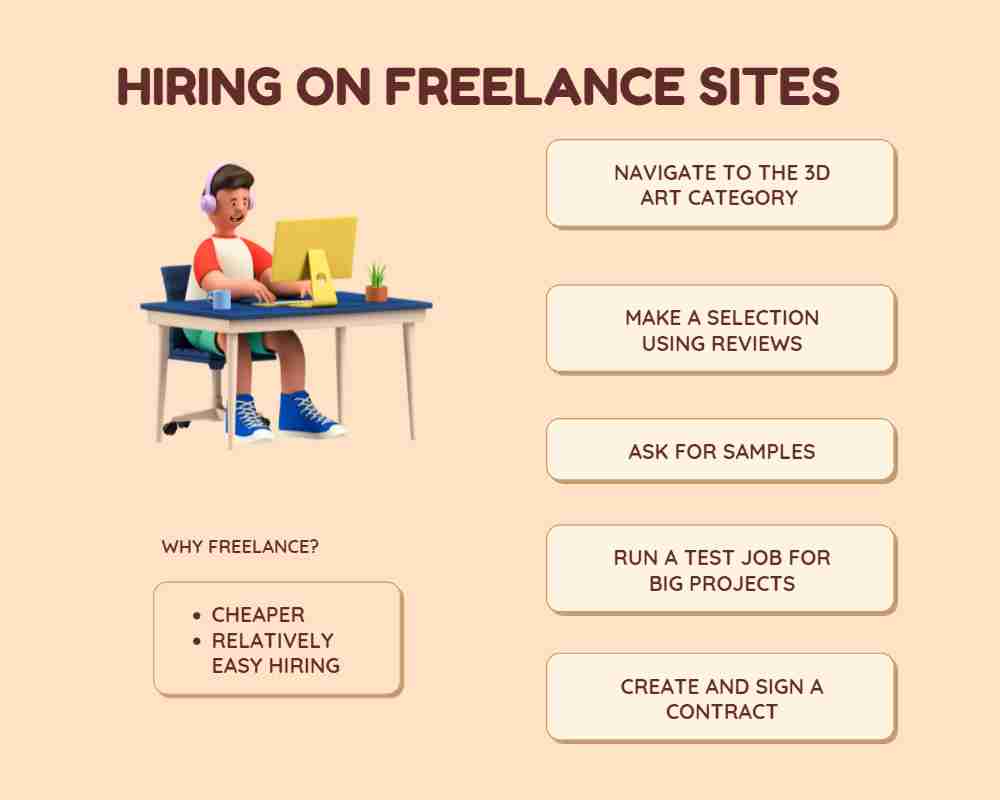
Both Fiverr and Upwork have dedicated 3D art categories reachable from their homepages. You can also directly search for the phrase ‘3D artist’ using the search bar on both platforms. Using the search functionality, however, leads you to a more dilute selection of freelancers, so you might have animation artists who can do 3D art appearing in the search results as opposed to just plain dedicated 3D artists. That said, the search function allows you to find freelancers with specific skills.
For instance, you can search for ‘3D artist *insert 3D creation software*’ if you want an artist who uses a particular 3D design software. If you wanted an even more specialized selection of 3D artists, you could simply post a job offer with your requirements. On Fiverr, This is done using the Buyers’ request segment. On Upwork, you post a job using the ‘Post a job’ option.
Step two trim down your selection
Whichever route you take in the first step should lead you to a selection of 3D artists. Your next objective would be to trim down this selection to a number you can work with, and this is something you can do by checking out their reviews. Freelance sites have the advantage of displaying reviews of past clients on the artists’ profiles. You’ll need to be sharp with your assessment of reviews anyway – they can be faked easily.
Assessing reviews
With five star reviews, the number is the relevant marker.
How many five star reviews does the 3D artist have? The more, the merrier (read: better). Like I said, reviews can be faked on freelance platforms – Fiverr is particularly notorious for this, so a 3D artist can easily concoct a series of five-star reviews to boost their profile.
The more the five-star reviews, the less the chances of the entirety of them being fake. You don’t need to worry about what the five-star reviews say. The freelancer is judged good by the platform, usually based on these five-star reviews, and that’s why you can see them through search or the categories listing page.
Both Fiverr and Upwork have intelligent ranking algorithms that work to push low performing 3D artists to the bottom of search results where they’re less likely to be seen.
Focus more on the negative reviews
By negative, I mean the three, two, one-star reviews. These are less likely to be fake, and in many cases, they unearth unapparent issues with any one particular 3D artist. Note that a negative review doesn’t automatically override positive reviews – you’d be hard-pressed to find any 3D artist without negative reviews. What you should take note of with reviews negative reviews are the complaints, how they were addressed by the 3D artist and the number of repeating complaints.
If a complaint directly applies to you, let’s say you’re someone who enjoys communicating with your hire through the project and a reviewer is citing communications issues with the freelancer; you want to see how they responded to the allegation.
Is the response level headed? Did they try to address the concern, or did they offer restitution? I’ve found that 3D artists and freelancers in general who accept the blame when necessary are easier to collaborate with (and often produce better results) than those who brush off every single complaint as an attack on their business.
Another thing to pay attention to with reviews is the similarity between individual reviews. If you’ve got several reviewers complaining of the same issue, then it doesn’t matter if the 3D artist addresses it or not. That’s an indication that they’re actually deficient in that regard, and it’s usually enough to discount their profile.
Step three – request portfolio samples and ask questions
Basically, just do what I described in the what to look out for segment. That is;
- Assess their creativity by going through their profiles on portfolio sites (dedicated or generalist).
- Assess their expertise with relevant 3D tools by asking questions on the tools they use and assessing their portfolio
- Checkout their skill and overall 3D art expertise by assessing portfolio samples and going through their industry experience.
Step two should’ve narrowed down your options to a couple of 3D artists. With step four, you should’ve made up your mind on which 3D artist to hire.
Step four – run a test job
Sometimes even if a 3D artist ticks all the checkboxes, you might want to run a test job to see if they’re an actual fit. The best way to conduct a test is to use a small part of your 3D art project as the test sample.
If you were doing full character development for a game, for instance, use one character as the test subject. Of course, it goes without saying that all test jobs should be paid for. Don’t be that guy who asks for test samples for free – virtually all 3D artists who are worth it will ignore such a request.
Step four is an additional step, and except you’ve got deep pockets, it’s not something I recommend for small one-off 3D art projects. If you’re planning on commissioning something large, maybe an animation or character development for a game or feature film, then it’s an absolute necessity when working with freelance 3D artists.
What are the advantages of going the freelance route
It is somewhat cheaper
Freelance 3D artists hired off freelance sites like Fiverr and Upwork have the best rates you’ll find anywhere in the industry. Much of that is down to the in-house competition among 3D artists happening on those sites, but part of it is also because freelance sites open you up to 3D artists from developing and third world countries with low cost of living and commensurately low starter rates.
Hiring is easy and fast
You can log in to a freelance site and expect to land a qualified 3D artist in less than an hour. Compared to a portfolio site like Arstation, where your inquiries are not promptly attended to and where you have to sometimes wait on a commissions queue.
Freelance sites also come with native contract functionality and escrow service, so you don’t have to worry about the 3D artist running off with your money.
The drawbacks
Harder to find extremely skilled talent
They exist on freelance sites for sure but in much lower numbers than a portfolio site like Artstation. Like I said earlier, the crème de la crème of 3D art need not set up freelance profiles, some of them do have freelance profiles, but for most, the job comes to them and not the other way round.
Finding and hiring a 3D artist on Artstation
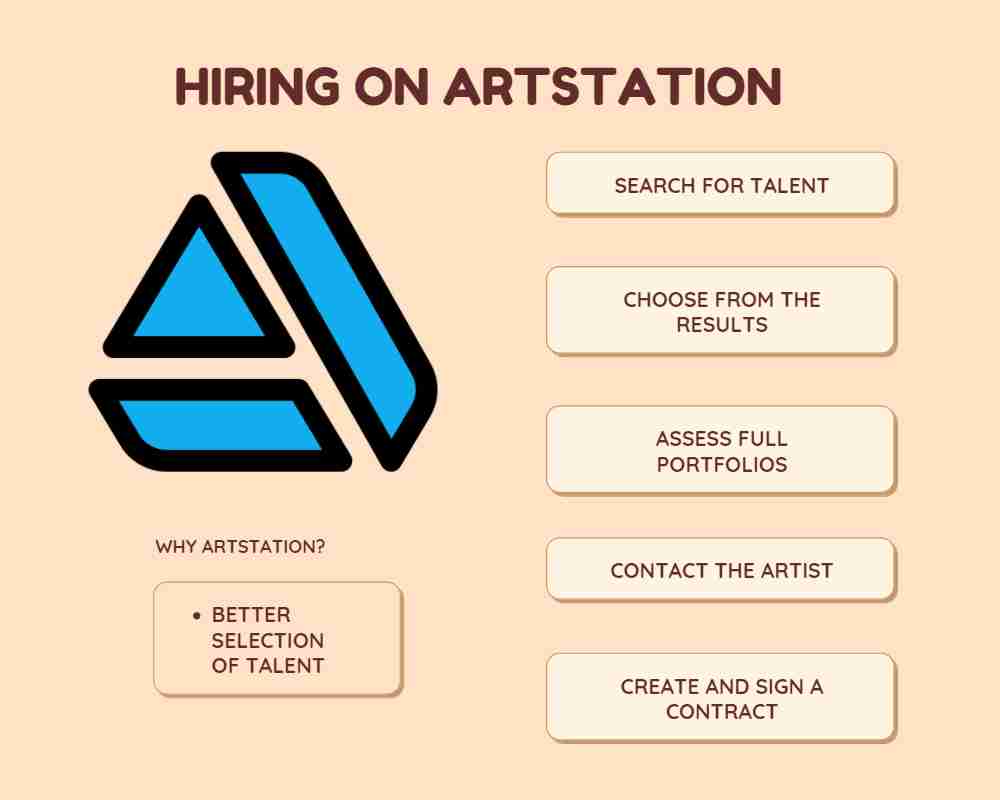
Artstation is a portfolio site for artists and an art marketplace; all merged into one. Epic Games recently acquired the platform, and since that time, it has sprawled into a HubSpot for high-reputation professional 3D artists. Let me quickly run down the steps you need to take to find 3D artists on Artstation.
Step one – search for talent
When it comes to searching for talent, Artstation has three relevant categories on its platform – marketplace, prints and studios. Each is an avenue to reach a 3D art specialist.
If you’re looking for a 3D artist for a one time, uncomplicated 3D art gig, going through Artstation marketplace or Printshop is a good strategy. Simply use the search phrase 3D art or any other specific 3D art keyword you might have. This will bring up relevant 3D artworks, and you can take it up from there.
The studio subcategory is a special subcategory that connects you with top draw art studios from the world over. Artstation is unique in that it’s the only option on this guide with an expansive list of 3D art studios. And these are the guys you’ll want to connect with if you have a large multidimensional 3D art project.
Navigate to the Studio subsection and search for 3D art or any other relevant 3D art phrase. This should bring up a list of the best-fit studio 3D art candidates for your task.
Alternatively, you could sign up for the Artstation recruiter program/plan, which is basically the post a job option you get with freelance sites with some added perks and a huge subscription fee. If you’re not planning to recruit something as large as a full-on animation team for a feature film or high rise game title, you shouldn’t bother with this.
Step two – make your picks
Artstation is a portfolio site, so you’re going to be seeing sample 3D art first before the profiles of their creator. It’s easier this way since you assess the art first before contacting the creator. Make a shortlist of the sample pieces that appeal to you.
Step three – assess full portfolios
Once you have a shortlist of artwork from search that appeals to you, you can simply click them and navigate to the artist’s profile by clicking the profile button top left on the cart page. From there, select the portfolio page option and scroll through. Use the assessment template I described in the what you should look out for segment to gauge the 3D artist. Like what you see? Time to establish first contact
Step four – contact the 3D artist
There’s a handy message now button on each artist’s profile page that allows you to reach out to potential hires. You want to keep your message short, simple and to the point. No need for extensive introductions or compliments. Instead, describe what you need done and ask if they’re available to work.
Step five – negotiate terms and finalize the deal
Not all messages you send will get a response, but most will. If you get a response and the 3Dartist is available for hire, now’s the time to touch down on the details and finalize the deal. You can ask questions about their industry experience and technical expertise at this stage.
If everything feels right, proceed to negotiate the terms of the project, requirements deliverables and delivery timelines.
All this should be documented in a hiring contract that the 3D artist signs after they’ve agreed to the terms.
A note on contract and payments
Artstation doesn’t have an inbuilt contract and escrow system, unlike freelance sites. Make sure you formulate a detailed contract that lists every key detail concerning the project.
You should also settle payment through payment channels with escrow and third-party mediation support. The standard for this is PayPal. Most artists will ask for an upfront partial settlement pending full settlement when the 3D is completed. This is normal practice, and provided you pay through a secured channel like PayPal, you should be covered from any eventualities.
The advantages of using Artstation
A better selection of professional 3D artists
While freelance sites have a larger number of 3D artists and their fair share of professionals, Artstation packs a more refined selection of professional 3D artists. This and the fact that they have more dedicated studios available for hire makes them one of the best places to staff high skill and 3D design roles.
The drawbacks
It’s expensive
3D artists you meet on Artstation will charge a higher premium than their counterparts on freelance websites. Artstation also charges a pricy $250 for their base offer recruiter plan, which you need to post a job request on the platform. Granted, it does come with some additional perks that make finding talent easier, but it’s still an expensive option.
Hiring a 3D artist from DeviantArt
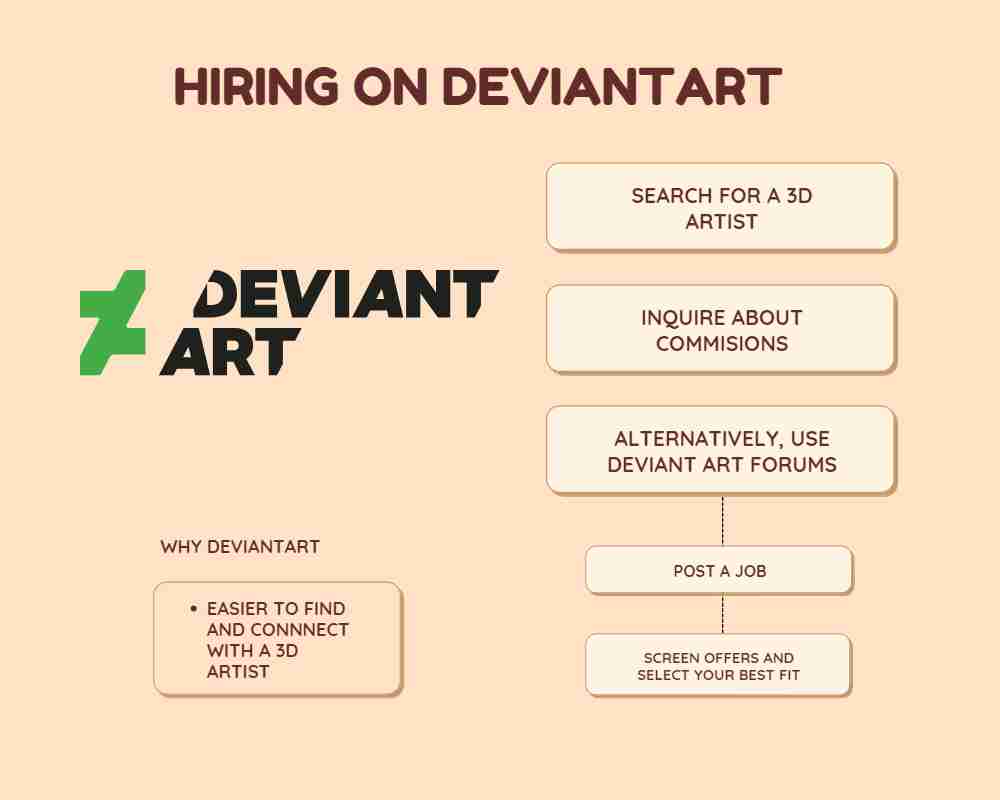
DeviantArt is a lot like Artstation, with the major difference being that it’s a forum-like portfolio site where the main emphasis is showcasing artwork. Artstation is an expertly managed portfolio site with an emphasis on finding and hiring talent.
Step one – search for a 3D artist on DeviantArt
Like freelance sites, DeviantArt has a rather powerful search algorithm that does all the background filtering to present you with the best-fit art matching your query. Simply search for 3D art or any other 3D specific keyword, and you should see a list of filtered artwork. Search results on Deviantart can be further grouped into:
- Deviations which are the actual artworks matching the search phrase
- Groups which are sub-forums on DeviantArt dedicated to the art type (3D art in this case)
- Artists which are artists who’ve consistently made 3D art
- Collections which are body of works related to 3D art.
Each filter provides a unique way to approach finding talent on DeviantArt. With groups, you can see a range of top and active 3D artists on DeviantArt. The artist filter makes it so that you can sort through 3D artists much like you would on a freelance site, only you don’t have reviews to help with preliminary selection.
The Collections tab is where you go if you want a general view of the kind of 3D artists you can hire on DeviantArt.
Most times, I stick with the Deviations filter since it allows me to directly sort artists based on their artwork. See what I like, click the art, navigate to the profile and do my assessment.
Step two – inquire about a commission
As was the case with Artstation, you can easily send a message to a 3D artist on DeviantArt. Deviantart also has a nice shop feature where you can directly purchase 3D art from an artist. Most 3D artists will have instructions on how to order a custom 3D art piece on this page but make sure to buzz first before ordering, so you can clarify the details and see if they’re a good fit.
Alternative step – use the DeviantArt forums
The DeviantArt forums allow you to post a 3D job offer just like you can do on freelance sites and on Artstation. As was the case with job offers on the other two hiring portals, this is an option that comes in handy if you’re looking for specific forms of 3D art or 3D artists’ skills.
The Job Offers forum on DeviantArt is available through this link. From there, you can directly post a job offer seeking a 3D artist. Remember to be as detailed with your requirements as possible.
Once your offer is posted, you’ll begin receiving applications from which you can screen and make your pick using the requirements I outlined earlier on. 3D artists’ profiles on Deviantart don’t have reviews, so you must be extremely picky with your portfolio screening and question asking rounds.
Why DeviantArt
It’s easier to connect with a 3D artist
DeviantArt is more of a social media site for artists of all orientations, so it’s way easier to reach out to someone and get a response compared to, say, ArtStation.
An expansive selection of 3D artists
Like freelance sites, DeviantArt is staffed with a growing number of 3D artists, most of which are available for hire. Note, however, that there are a lot of amateurs here, same case with freelance sites, so it’s up to you to do your due diligence when hiring if you want top-draw talent.
The drawbacks
Low levels of professionalism
There are a lot of wannabe 3D artists on DeviantArt. If you’re unlucky to hire one, be prepared to deal with everything from poor communication to missed deliveries, botched jobs or even outright scams.
Which is the best option

Of the three, which 3D artist hiring option should you use? Well, it all depends on your needs – it sounds cliché, but that’s the truth.
If you need a conventional 3D art piece done and done snappily without any hectic hiring process, then freelance sites are the best option. It’s pretty much plug (pay) and play (get art). Plus, with the artist reviews selecting a good 3D artist is a less tricky prospect.
If you’re creating something elaborate, something in the lines of a full-length animation or game title character development, then Artstation is a better place to start your search. The talent on here is superior to the other options, and you even get the chance to hire full-on studios. But you must have deep pockets, of course.
DeviantArt is sort of the in-betweener. You can get top-draw artists from the platform, and it’s also a good place to hire for one-off projects. I personally reserve it for those niche-type 3D art pieces. Something that would be hard finding a suitable candidate on a freelance site or Artstatioon.
A note on contracts and copyrights
I’ve already mentioned that your contract should be as explicit and detailed as possible. This is important because of disputes that may arise between you and the 3D artist. If everything’s clear from the get-go, it’s easier to resolve such disputes.
Copyrights are an important aspect of hiring any artist on a contract or third-party basis. You should draft up a copyrights document and get the artist to sign off on it before completing the hiring process. Ideally, you want a copyrights lawyer to formulate this document, and if it’s a major project, you definitely should get a lawyer.
That said, with one-off small to mid-size projects, you can get away with drafting up a document yourself. I’ve attached a sample copyrights document below.
Make sure to discuss the copyright terms in full with the artist. You want to clarify who owns the full copyrights to any piece you commissions and what usage access each party retains on the art piece. For instance, you want to clarify if the artist has permission to use your artwork as samples on their profiles or portfolio pages.
Being clear and upfront with copyrights from the get-go will save you a lot of stress and, in many cases, extra costs that could potentially come up with copyrights claims. Don’t skip it!
Conclusion
Hiring a 3D artist is not rocket science, and I know I did say they were scarce – yes, scarce compared to many other art disciplines but still enough to go around everyone who needs a 3D art position staffed. Most times, all you need is where best to find the talent you want, and in this guide, I’ve provided solid information on the best places to find top-draw 3D artists from anywhere in the world.
Got questions? Ask via the comment section.
